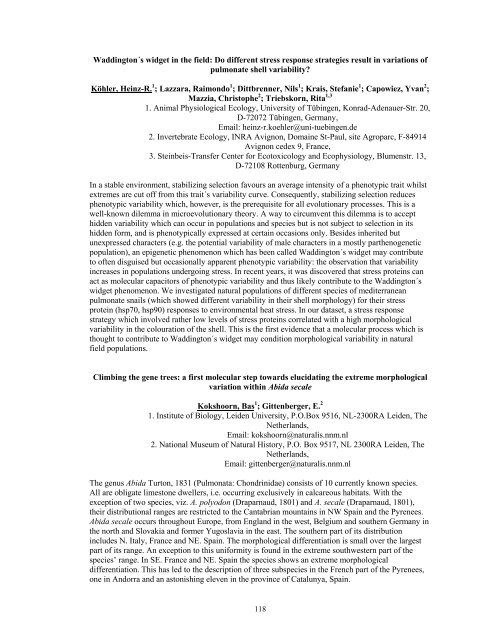World Congress of Malacology Antwerp ... - Unitas Malacologica
World Congress of Malacology Antwerp ... - Unitas Malacologica
World Congress of Malacology Antwerp ... - Unitas Malacologica
Create successful ePaper yourself
Turn your PDF publications into a flip-book with our unique Google optimized e-Paper software.
Waddington´s widget in the field: Do different stress response strategies result in variations <strong>of</strong><br />
pulmonate shell variability?<br />
Köhler, Heinz-R. 1 ; Lazzara, Raimondo 1 ; Dittbrenner, Nils 1 ; Krais, Stefanie 1 ; Capowiez, Yvan 2 ;<br />
Mazzia, Christophe 2 ; Triebskorn, Rita 1,3<br />
1. Animal Physiological Ecology, University <strong>of</strong> Tübingen, Konrad-Adenauer-Str. 20,<br />
D-72072 Tübingen, Germany,<br />
Email: heinz-r.koehler@uni-tuebingen.de<br />
2. Invertebrate Ecology, INRA Avignon, Domaine St-Paul, site Agroparc, F-84914<br />
Avignon cedex 9, France,<br />
3. Steinbeis-Transfer Center for Ecotoxicology and Ecophysiology, Blumenstr. 13,<br />
D-72108 Rottenburg, Germany<br />
In a stable environment, stabilizing selection favours an average intensity <strong>of</strong> a phenotypic trait whilst<br />
extremes are cut <strong>of</strong>f from this trait´s variability curve. Consequently, stabilizing selection reduces<br />
phenotypic variability which, however, is the prerequisite for all evolutionary processes. This is a<br />
well-known dilemma in microevolutionary theory. A way to circumvent this dilemma is to accept<br />
hidden variability which can occur in populations and species but is not subject to selection in its<br />
hidden form, and is phenotypically expressed at certain occasions only. Besides inherited but<br />
unexpressed characters (e.g. the potential variability <strong>of</strong> male characters in a mostly parthenogenetic<br />
population), an epigenetic phenomenon which has been called Waddington´s widget may contribute<br />
to <strong>of</strong>ten disguised but occasionally apparent phenotypic variability: the observation that variability<br />
increases in populations undergoing stress. In recent years, it was discovered that stress proteins can<br />
act as molecular capacitors <strong>of</strong> phenotypic variability and thus likely contribute to the Waddington´s<br />
widget phenomenon. We investigated natural populations <strong>of</strong> different species <strong>of</strong> mediterranean<br />
pulmonate snails (which showed different variability in their shell morphology) for their stress<br />
protein (hsp70, hsp90) responses to environmental heat stress. In our dataset, a stress response<br />
strategy which involved rather low levels <strong>of</strong> stress proteins correlated with a high morphological<br />
variability in the colouration <strong>of</strong> the shell. This is the first evidence that a molecular process which is<br />
thought to contribute to Waddington´s widget may condition morphological variability in natural<br />
field populations.<br />
Climbing the gene trees: a first molecular step towards elucidating the extreme morphological<br />
variation within Abida secale<br />
Kokshoorn, Bas 1 ; Gittenberger, E. 2<br />
1. Institute <strong>of</strong> Biology, Leiden University, P.O.Box 9516, NL-2300RA Leiden, The<br />
Netherlands,<br />
Email: kokshoorn@naturalis.nnm.nl<br />
2. National Museum <strong>of</strong> Natural History, P.O. Box 9517, NL 2300RA Leiden, The<br />
Netherlands,<br />
Email: gittenberger@naturalis.nnm.nl<br />
The genus Abida Turton, 1831 (Pulmonata: Chondrinidae) consists <strong>of</strong> 10 currently known species.<br />
All are obligate limestone dwellers, i.e. occurring exclusively in calcareous habitats. With the<br />
exception <strong>of</strong> two species, viz. A. polyodon (Draparnaud, 1801) and A. secale (Draparnaud, 1801),<br />
their distributional ranges are restricted to the Cantabrian mountains in NW Spain and the Pyrenees.<br />
Abida secale occurs throughout Europe, from England in the west, Belgium and southern Germany in<br />
the north and Slovakia and former Yugoslavia in the east. The southern part <strong>of</strong> its distribution<br />
includes N. Italy, France and NE. Spain. The morphological differentiation is small over the largest<br />
part <strong>of</strong> its range. An exception to this uniformity is found in the extreme southwestern part <strong>of</strong> the<br />
species’ range. In SE. France and NE. Spain the species shows an extreme morphological<br />
differentiation. This has led to the description <strong>of</strong> three subspecies in the French part <strong>of</strong> the Pyrenees,<br />
one in Andorra and an astonishing eleven in the province <strong>of</strong> Catalunya, Spain.<br />
118



